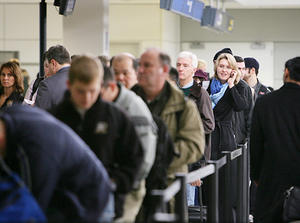Stemming the spread of disease at airports
With roughly two million people flying each day and spending hours in confined areas where they will come into close contact with potentially infected people, air travel poses a serious challenge to public health officials seeking to contain major disease outbreaks; last month public health officials scrambled to contain a potential mass outbreak of measles after a woman flew through three U.S airports, coming into contact with thousands of people; a CDC report recommends using infrared thermal scanners to detect passengers with fevers as that is an easily recognizable symptom and it is a common indicator of most infectious diseases

Crowded airports are ideal for disease transmission // Source: nj.com
The recent measles outbreak at three U.S. airports around the country has raised the issue of preventing the spread of disease at airports. With roughly two million people flying each day and spending hours in confined areas where they will come into close contact with potentially infected people, air travel poses a serious challenge to public health officials seeking to contain major disease outbreaks.
Last month U.S. public health officials scrambled to contain a potential mass outbreak of measles after a woman flew through airports in Denver, Albuquerque, and Washington, D.C. and came into contact with thousands of people.
Measles is a highly infectious disease that can be easily transmitted through coughing or sneezing and can remain in the air for up to two hours. Officials detected bacteria that could transmit measles at all three airports.
In a similar case, last month New Zealand health officials raced to prevent a measles outbreak after nine passengers aboard a flight may have infected hundreds of others. Officials quarantined the nine infected individuals and closely monitored the other passengers aboard the flight and those they came in contact with.
Measles has a low fatality rate, but last month’s problem highlights the challenge of preventing the spread of more deadly diseases at transportation hubs.
A report by the Centers for Disease Control and Prevention (CDC) writes, “Advancements in transportation coupled with the growth and movement of human populations enable efficient transport of infectious diseases almost anywhere in the world within 24 hours.”
To help stem the spread of disease, the report recommends using infrared thermal scanners to detect passengers with fevers as that is an easily recognizable symptom and it is a common indicator of most infectious diseases.
These scanners serve as a non-invasive method to quickly screen large numbers of people. During the SARS outbreak in 2003 and the H1N1 pandemic in 2009, airports and other major transportation hubs deployed these scanners to detect infected persons.
In a report published by the Canadian Medical Association Journal, researchers determined that SARS was spreading around the globe rapidly as a result of air travel.
Other proven screening methods to deter the spread of disease include visual inspections and self-reporting.
In the event of an outbreak, Airports Council International, a worldwide association of airport operators, recommends not allowing infected persons to travel aboard aircraft and the creation of screening facilities at airports.
